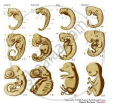Advertisements
Advertisements
Question
Explain the importance of Anatomical evidences with examples.
Solution
- Anatomical evidences are the similarities in structures and anatomy between different organisms.
- The hand of a human, foreleg of ox, flipper of whale, and forelimbs of bat appear different superficially or morphologically.
- Also, the function of these structures is different in different animals.
- However, there is a similarity in the structure of bones and bony joints in the organs of these animals.
- These similarities indicate that the animals evolved from a common ancestor thus providing proof of evolution.
APPEARS IN
RELATED QUESTIONS
Mammals : _________ : : Amphibia : Fishes
Which of the following pairs of two vegetables represent the correct homologous structures?
(A) Sweet potato and potato
(B) Sweet potato and tomato
(C) Carrot and potato
(D) Radish and carrot
Write the similarity between the wing of a butterfly and the wing of a bat. What do you infer from the above with reference to evolution?
Select two pairs from the following which exhibit divergent evolution. Give reasons for your answer.
(i) Forelimbs of cheetah and mammals
(ii) Flippers of dolphins and penguins
(iii) Wings of butterflies and birds
(iv) Forelimbs of whales and mammals
Differentiate between analogy and homology giving one example each of plant and animal respectively.
How analogy and homology considered as an evidence in support of evolution ?
Four students P, Q, R and S differently reported the following set of organs to be analogous :
P. Forelimb of a frog and forelimb of a lizard
Q. Forelimb of a bird and forelimb of a human
R. Wings of a parrot and wings of a butterfly
S. Wings of a bird and wings of a bat
The two students who have reported correctly are :
(A) P and Q
(B) Q and R
(C) R and S
(D) P and S
The organs which perform different functions but have the same basic structure are known as :
(a) homologous organs
(b) analogous organs
(c) homolytic organs
(d) analytic organs
The wings of a housefly and the wings of a sparrow are an example of :
(a) analogous organs
(b) vestigial organs
(c) respiratory organs
(d) homologous organs
In a class, students were asked to observe the models/slides/pictures of the skeletons of forelimbs and wings of different organisms. After the observations the students made the following groups of homologous structures. Select the correct group :
(A) Wings of a bird and a butterfly
(B) Wings of a pigeon and a bat
(C) Wings of a butterfly and a bat
(D) Forelimbs of a cow, a duck and a lizard
Read the following statement and justify same in your own words with the help of suitable example.
There is evidences of fatal science among chordates.
Write short notes based upon the information known to you.
Connecting link
Observe the picture and answer the following questions.
A) Which evidence of evolution is shown in the picture?
B) What can be proven with this proof?
C) Give one more example of evidence of evolution
Answer the following question.
Wisdom teeth : Vestigial organs :: Lungfish : ....................
Draw a labelled diagram of T.S. of a leaf showing Kranz anatomy.
What do you mean by vestigial structures? Name four vestigial organs found in man.
Answer the following question:
What are homologous structures? Give an example. Is it necessary that homologous structures always have a common ancestor? Justify your answer.
Very short answer question.
What are homologous organs?
Find an odd one out.
Find an odd one out.
Match the following.
| Column A | Column B |
| 1) Morphological evidences | a) Tail-bone or wisdom teeth |
| 2) Paleontological evidences | b) Leaf venation |
| c) Fossils |
Give scientific reason.
Duck-billed platypus shows relationship with mammals.
Observe the given images and answer the following questions.

- Which evolutionary evidence does it indicate?
- What does it prove?
- State another example of evolutionary evidence.
Select vestigial organs from the following.
Where is carbon dating used?
Evolutionary convergence is the development of:
Which is not a vestigial organ in a man?
Appearance of antibiotic-resistant bacteria is an example of ______.
What are we referring to? When we say 'simple organisms' or 'complex organisms'.
How do we compute the age of a living tree?
Complete the following chart:

As shown in figure below some organisms that share a common ancestor have features that have different functions, but similar structures.

These are known as ______. Give example.
Define the term:
Homologous organs
Industrial melanism was highlighted by ______.
Industrial melanism in England after 1850 is an excellent example of Natural selection. Explain how?
Pick the odd man out:
